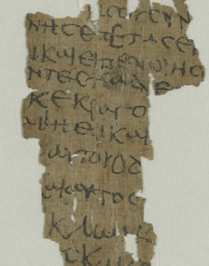Sensationalized headlines
throughout the world introduced the story of a manuscript fragment discovered in
the library at Humboldt University in Hamburg Germany. The headline of CBS News
was typical, reading, “Newly deciphered manuscript is oldest written record of
Jesus Christ's childhood, experts say.”
The truth is that this fragment is useless when it comes to obtaining real knowledge about Jesus. It is part of a work entitled The Infancy Gospel of Thomas, which is a part
of a group of writings that emerged after the first century containing fanciful
stories and legends about Jesus. The authors of these spurious writings often
used the name of an apostle or other famous person to add a sense of
authenticity to their work.
These works are known as the Apocryphal New Testament and they
include such books as The Protoevangelium, The Gospel of the
Birth of Mary, The First Gospel of the Infancy of Jesus Christ, The
Gospel of Thomas, The Infancy Gospel of Thomas, and others.
Philip Yancey described these apocryphal gospels as “second-century counterparts to modern comic books about Superboy and Batgirl” (Hyatt, (Hyatt, Discovering the Real Jesus, 46-47). He is right!
For example, in The Infancy Gospel of Thomas, of which this fragment is a part, the boy Jesus makes clay pigeons but is rebuked by Joseph for making them on the Sabbath. Jesus then claps his hands, speaks to the pigeons, and they come to life and fly away.
This spurious gospel also tells of a young boy running and bumping into Jesus who curses the boy and causes him to die. When the boys parents and others in the village complain to Joseph, Jesus strike them all with blindness.
If
someone has read and studied the four Gospels, they will sense an immediate and
distinct difference when reading these works. Their stories come across as fanciful
and inauthentic. They do not have the genuine sense of the four Gospels, nor
are they inspirational and faith-building.
These and other apocryphal
writings were rejected by the earliest church fathers, such as Irenaeus
(125-200), Tertullian (160-240), and others.
In 367, Athanasius (298-373), Bishop of Alexandria,
wrote a letter in which he warned of these apocryphal writings. He listed the
27 books of the New Testament that were already accepted throughout Christendom,
and said,
Let no one add to these or take anything from them. No mention is to be made of the apocryphal works. They are the invention of heretics, who write according to their own will, and gratuitously assign and add to them dates so that, offering them as ancient writings, they may have an excuse for leading the simple astray (Hyatt, Discovering the Real Jesus, 47).
Cyril of Jerusalem (313-386) also warned of spurious gospels, saying,
Of the New Testament, there are only four gospels; for the rest are not genuine and are harmful. The Manicheans also wrote a “Gospel according to Thomas,” which, through the spurious odor of sanctity conferred by its title, corrupts the simple folk (Hyatt, Discovering the Real Jesus, 48).
The New
Testament canon is one thing about which all sectors of Christianity agree. Catholics, Protestants, and Eastern Orthodox
all agree that the twenty-seven books of our New Testament comprise the canon
and are authoritative for all followers of Christ.
Despite
the evidence, modern Gnostics and New Age types tend to embrace these
apocryphal writings since they undergird their own
esoteric, mystical theories. They publish them with enticing titles,
such as The Lost Books of the Bible, The Missing Books of the Bible, and The Jesus Papers. However, they are not lost or missing,
and they tell us nothing about the real Jesus. They were rejected as spurious and inauthentic from the very
beginning.
This article was derived from Discovering the Real Jesus by Dr. Eddie L. Hyatt and is available from Amazon and his website at http://eddiehyatt.com.

No comments:
Post a Comment